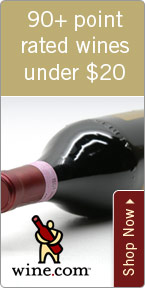A Cleansing, Crisp Chablis

Wednesday - July 21, 2006
| Share
 Del.icio.us
Del.icio.usA couple of weeks ago I spent four days gorging on great food and wine at the Kapalua Food and Wine Festival on Maui. Every day there was great food prepared by some of the best chefs in the U.S., like Ming Tsai, Julian Serrano and Andrew Sutton. We had wines from all over the globe, Champagne to Jurancon and Cabernet to Zinfandel. And on one particular evening after all that tasting, eating and drinking, in the dark of midnight, what I craved most was the steely refreshment of Chablis as an after-dinner drink.
No, not the Chablis that comes from Modesto, Calif., in a jug. I’m talking about the genuine article from France. The limpid white wine with a tinge of green, the wine that smells like minerals and citrus, the wine that almost crackles on your palate with zesty acidity, cleansing almost anything you may have tasted before it. A chilled glass that would revive my palate for the late night of wine tasting with some of my fellow master sommeliers who were in attendance. That is what I craved. Perhaps a little fatigued by the copious amounts of strong flavors of food and the warmth of alcohol already coursing in my veins, I needed the lift.
Chablis can only come from the appellation of Chablis, France, which is located almost 100 miles southeast of Paris. It is made from only Chardonnay, but is unlike any other Chardonnay wine anywhere. What sets it apart is the very cool and often cold climate that the grapes are grown in, not allowing the grapes to reach such high sugar levels as areas such as California or Australia. The grapes also retain a higher acidity that is integral to its type and longevity. It is also planted in a specific type of soil that almost no other wine region enjoys, a soil known as Kimmeridgian clay. (Note to wine geeks: There is also some Portlandian, which is less favored.) This chalky soil is actually made up of the fossil remains of ancient seashells, which tasters and drinkers alike can sometimes find in the wine’s flavor and aroma. It is from this soil alone that true Chablis is born. For our ease of enjoyment, but not necessarily for ease of choosing, the vineyard sites of Chablis have been classified in a hierarchy (from lowest to highest) either as Petite Chablis, Chablis, Chablis Premier Cru, and Chablis Grand Cru, of which there are only seven.
At its best, Chablis should smell of minerals and fruit, not of oak and spice. It can be green in color and in aroma with scents of herbs and green fruits. It has a penetrating and intense flavor, much like a laser beam with a knife edge of acidity and dry finish. It should never be heavy or alcoholic, but is ponderous in complexity and long in flavor. The best can match the intensity and concentration of any Riesling and has as much elegance and class as any Montrachet.
It is a match made in heaven with oysters - anyway you decide to cook them or not cook them. Most seafood does well with Chablis: sautéed shrimp or ceviche, or even a piece of white fish with a creamy, fatty butter sauce - yummy! Chablis is also splendid as an aperitif, refreshing your palate and getting it all lubed up for some food. And it’s also great as your last glass of wine after a long day (and night) of working your palate and stomach overtime. Trust me, it works.
A couple of Chablis to try: 2004 Lavantureux Chablis ($15) Awesome value for your money. Plenty of orchard fruit with a mineral edge, zingy on the palate. This is a regular for me at home. 2004 William Fevre Chablis Grand Cru ‘Les Preuses’ ($39)
Wow, this is ultra-regal stuff.
Beautiful complexity, stunning fruit and a finish that goes on and on. You must try it to believe.
Roberto Viernes is a master sommelier. E-mail .(JavaScript must be enabled to view this email address)E-mail this story | Print this page | Comments (0) | Archive | RSS Comments (0) |
Most Recent Comment(s):












